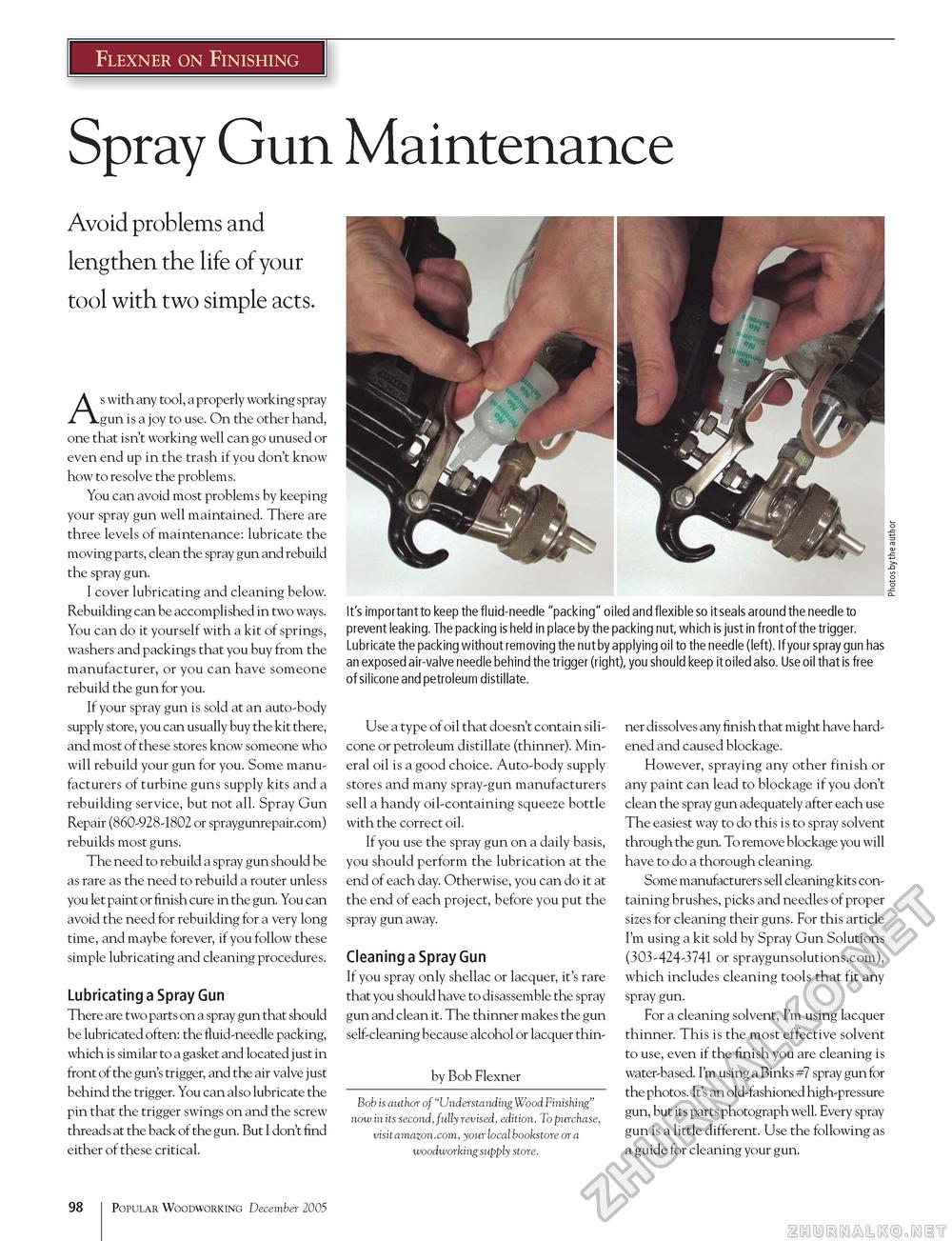Popular Woodworking 2005-12 № 152, страница 97
Flexner on Finishing Spray Gun Maintenance Avoid problems and lengthen the life of your tool with two simple acts. As with any tool, a properly working spray gun is a joy to use. On the other hand, one that isn't working well can go unused or even end up in the trash if you don't know how to resolve the problems. You can avoid most problems by keeping your spray gun well maintained. There are three levels of maintenance: lubricate the moving parts, clean the spray gun and rebuild the spray gun. I cover lubricating and cleaning below. Rebuilding can be accomplished in two ways. You can do it yourself with a kit of springs, washers and packings that you buy from the manufacturer, or you can have someone rebuild the gun for you. If your spray gun is sold at an auto-body supply store, you can usually buy the kit there, and most of these stores know someone who will rebuild your gun for you. Some manufacturers of turbine guns supply kits and a rebuilding service, but not all. Spray Gun Repair (860-928-1802 or spraygunrepair.com) rebuilds most guns. The need to rebuild a spray gun should be as rare as the need to rebuild a router unless you let paint or finish cure in the gun. You can avoid the need for rebuilding for a very long time, and maybe forever, if you follow these simple lubricating and cleaning procedures. Lubricating a Spray Gun There are two parts on a spray gun that should be lubricated often: the fluid-needle packing, which is similar to a gasket and located just in front of the gun's trigger, and the air valve just behind the trigger. You can also lubricate the pin that the trigger swings on and the screw threads at the back of the gun. But I don't find either of these critical. | yr I 1 2if / r\ jb. It's important to keep the fluid-needle "packing" oiled and flexible so it seals around the needle to prevent leaking. The packing is held in place by the packing nut, which is just in front of the trigger. Lubricate the packing without removing the nut by applying oil to the needle (left). If your spray gun has an exposed air-valve needle behind the trigger (right), you should keep it oiled also. Use oil that is free of silicone and petroleum distillate. Use a type of oil that doesn't contain silicone or petroleum distillate (thinner). Mineral oil is a good choice. Auto-body supply stores and many spray-gun manufacturers sell a handy oil-containing squeeze bottle with the correct oil. If you use the spray gun on a daily basis, you should perform the lubrication at the end of each day. Otherwise, you can do it at the end of each project, before you put the spray gun away. Cleaning a Spray Gun If you spray only shellac or lacquer, it's rare that you should have to disassemble the spray gun and clean it. The thinner makes the gun self-cleaning because alcohol or lacquer thin- by Bob Flexner Bob is author of "Understanding Wood Finishing" now in its second, fully revised, edition. To purchase, visit amazon.com, your local bookstore or a woodworking supply store. ner dissolves any finish that might have hardened and caused blockage. However, spraying any other finish or any paint can lead to blockage if you don't clean the spray gun adequately after each use The easiest way to do this is to spray solvent through the gun. To remove blockage you will have to do a thorough cleaning. Some manufacturers sell cleaning kits containing brushes, picks and needles of proper sizes for cleaning their guns. For this article I'm using a kit sold by Spray Gun Solutions (303-424-3741 or spraygunsolutions.com), which includes cleaning tools that fit any spray gun. For a cleaning solvent, I'm using lacquer thinner. This is the most effective solvent to use, even if the finish you are cleaning is water-based. I'm using a Binks #7 spray gun for the photos. It's an old-fashioned high-pressure gun, but its parts photograph well. Every spray gun is a little different. Use the following as a guide for cleaning your gun. 98 102 Popular Woodworking December 2005 |








